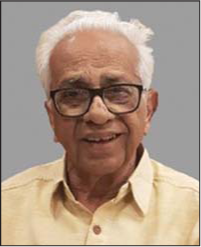Translate this page into:
K.V. Desikan (21 March 1926–23 October 2022)
Department of Medicine Mahatma Gandhi Institute of Medical Sciences, Sevagram, Wardha, Maharashtra, India sp.kalantri@gmail.com
[To cite: Kalantri SP. Obituary: K.V. Desikan. Natl Med J India 2023; 36:36:63. DOI: 10.25259/NMJI_964_2022]

Dr K.V. Desikan, a legend in the field of leprosy, passed away on 23 October 2022. He was 96.
In a career spanning more than 60 years, Dr Desikan played multiple roles, that of a doctor, a field worker, an epidemiologist, a researcher, a scientist and an administrator. Leprosy, in the early 1950s evoked considerable fear even among doctors. That was when he started work on leprosy.
Born in 1926 as the eleventh child among twelve siblings, Dr Desikan joined Mysore Medical College in the MBBS batch of 1944. By the time he graduated, he was deeply influenced by Gandhian ideals.
Having been diagnosed with leprosy himself as a medical student, Dr Desikan had personal experience of the trials and tribulations that followed a diagnosis of leprosy in those days. Interactions with Dr Cochrane and Dr Paul Brand at the Christian Medical College and Hospital, Vellore, during the course of his treatment, led to the beginning of his interest in leprosy work.
Dr Desikan joined the Gandhi Memorial Leprosy Foundation (GMLF), Wardha, Maharashtra, in 1952. Spearheading a leprosy control initiative in 35 villages in the area, he walked, cycled, took a bullock cart, travelled horseback and waded across rivulets to carry out door-to-door examination of every individual in each of these villages. He repeatedly examined more than 30 000 individuals and diagnosed 550 with leprosy. This was the world’s first survey, education and treatment (SET) programme for the diagnosis and management of leprosy. The programme paved the way for control of leprosy in India and the Government of India eventually started the National Leprosy Control Programme (NLCP) in 1955 and the SET method became the standard procedure for leprosy control in the country. Later endorsed by the WHO, the method was implemented worldwide.
In 1957, Dr Desikan was transferred to the Chilakalapalle Unit of GMLF in Shrikakulam (presently Vijayanagaram) district, a semi-tribal area of Andhra Pradesh. His mandate was to strengthen leprosy control work in that area. ‘Leprosy was rampant there and I was treating nearly 15 000 leprosy patients,’ recalled Dr Desikan once. To make his services more accessible, Dr Desikan provided voluntary services in many villages beyond the purview of the unit.
At the age of 36 years, in 1962, he enrolled for a postgraduate degree in Pathology at the Christian Medical College in Vellore, the very institute where he had been treated many years ago. He carried out the largest series of autopsy studies on leprosy patients there, and finished his MD Pathology in 1966.
In 1967, he joined the Central Leprosy Teaching and Research Centre at Chingleput (now Chengalapattu), near Madras (Chennai). During the course of his tenure there, he undertook a WHO fellowship for training in academic institutions in the UK, USA and Japan. Back in India, he pioneered studies on mouse footpad experiments to further understand the pathogenesis of the disease.
He took charge as Director of JALMA, Agra, in 1976. JALMA (an acronym for the Japanese Leprosy Mission for Asia) had been taken over by the Government of India, through the Indian Council of Medical Research (ICMR). Soon, the institute earned a name for outstanding clinical work and research. JALMA also hosted many national and international workshops, symposia and conferences on leprosy, and found a place on the national and international map.
Dr Desikan retired from JALMA in 1987 and came back to Sevagram, Wardha. With the help of LEPRA, the British Leprosy Relief Association, he set up a leprosy histopathology laboratory in the Mahatma Gandhi Institute of Medical Sciences (MGIMS), Sewagram. He took charge as the first Chairman of LEPRA India, headquartered in Secunderabad, till he stepped down in 2003. Dr Desikan steered LEPRA India through many leprosy control activities in Andhra Pradesh and tribal areas of Koraput, Orissa. Some years later, he moved to Bhopal to be with his daughter, and continued providing voluntary services to leprosy patients and handicapped children till he was 90 years of age.
Dr Desikan generated a wealth of evidence in over 150 publications, which is acknowledged with the respect that it deserves. His work encompassed the entire spectrum of leprosy: descriptive epidemiology, diagnostics, histopathology, immunology, physiology, therapy and simple clinical observations.
Some of the honours he received were the ICMR/JALMA Oration Award, the KC Sahu Gold Medal, the Gold Medal of the Argentina Leprosy Foundation, the Certificate of Honour, Medical Research Institute, Florida Institute of Technology. In 2001, he received the Damien-Dutton Award—the highest international recognition for work in leprosy—for ‘dedicating his life to bring to “God’s poorest of the poor” a sense of self-worth’. His response to the award was characteristically humble: ‘I feel honoured, but I have to remind myself that I am no greater than several others who have worked, struggled, sacrificed and remained unknown.’ Recently, a laboratory complex was named after him in JALMA, Agra.
In his long and illustrious career, he nurtured the careers of many, helping them reach international heights. He leaves behind a rich legacy of service to humanity.




